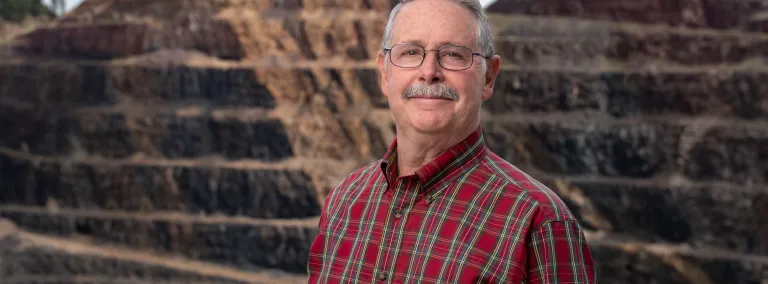New discoveries from the same old rocks
David Vardiman retires after 30 years as a geologist with Homestake Gold Mine and Sanford Underground Research Facility.
As a young boy, David Vardiman contracted rheumatic fever. For months, his joints inflamed and his muscles weak, Vardiman was unable to walk by himself. His older siblings would sometimes cart their restless brother around the neighborhood in a small wagon, but mostly, he passed his days in bed, flipping through the encyclopedia volumes his mother had given him.
His eyes widened at the glossy pictures of fossils: the flush compartments of swirled ammonites, a T-rex scull imprinted on weathered rock, the delicate veins of a long-extinct fern. When he recovered from the illness, Vardiman began hunting fossils in the Missouri hillsides near his home. He remembers unearthing handfuls of brachiopods, fragile mollusks no bigger than turnip seeds, and trying to find a way to bring them home without crushing them in his pockets.
“I tucked them in my lower lip, like a hamster,” Vardiman recalled with a chuckle. “And then, when I came home, I cleaned out my lips to show all these neat fossils I found—to the disgust of my sisters.”
As he grew up, Vardiman’s interest soon shifted from fossils to the rock itself. Vardiman studied geology at South Dakota School of Mines & Technology and worked as a summer student at Homestake Gold Mine. Homestake, already the largest and deepest gold mine in the Western Hemisphere, was growing rapidly. Mining crews drove Homestake’s drifts deeper into the rock formation and Vardiman was on their heels, documenting the newly exposed rock.
“These were top of the game, the best miners we had. They knew how to put in a drift quickly and efficiently, so you better not hold them up for anything. But I had to be right behind them, trying to record all the detailed geology that was being exposed day on day,” Vardiman said.
He took notes on a field sheet, using specialized symbol sets and shorthand to indicate where fractures and folds appeared in the Earth’s crust. By the end of a shift, he would bring his field sheet, grubby and smeared, to the senior geologist’s office to be scrutinized.
“Most of my early maps ended up in the trash can. And I was made to go back and remap the exact same place without my previous observations,” Vardiman said. “And through that process, finally, after about a month, the geologist said, ‘Okay, correct this and this, go back and recapture this portion, and then you may put it on to the permanent maps.’ Then I was finally able to transcribe what I had done in permanent ink.”
Homestake’s geologists examined these maps, interpreting each feature of the exposed rock to determine where gold deposits were located. Vardiman learned to decipher what he calls “the vagaries of Mother Nature.”
“There are no libraries, no books you can consult that will tell you the exact characteristics of any given geologic formation. Mother Nature doesn’t allow for it. You have to compensate by studying the intricacies of each unique formation,” Vardiman said.
Vardiman went on to lead mining exploration crews across the globe—from remote mining districts in the mountains of Colorado and Nevada to international mines in Argentina, Chile and Canada. In 1988, Vardiman returned as Homestake’s chief geologist during the final decade of mining. And in 2009, Vardiman returned to Lead, South Dakota, once again. By then, the mine had closed and the Sanford Underground Research Facility was becoming a reality.
As a project engineer, Vardiman helped the facility design, excavate and maintain large laboratory caverns within the unique rock formations underground. For more than a decade, Vardiman drew upon his vast institutional knowledge of the facility to ensure SURF would be a safe, lasting location for underground science.
He designed the pattern of rock bolts and lacing in the 5,000-foot-deep Ross Shaft, which had withstood 90 years of heavy traffic and must endure decades into the future. He also monitored the walls of newly excavated caverns to make sure the rock would not converge as science continued. Vardiman worked closely with Fermilab crews to design massive underground caverns for the Long-Baseline Neutrino Facility and Deep Underground Neutrino Experiment, which will be the largest international particle physics experiment on U.S. soil.
In this role, Vardiman has had a front row seat to experiments that utilize SURF as testbed for cutting-edge geologic research.
“There have been a number of experiments, both past and current, that have been incredibly intriguing,” Vardiman said, listing Transparent Earth, one of the world’s largest seismic arrays, and SIGMA-V, which studies how fracture networks could be used to extract geothermal energy from Earth’s deep, hot rocks.
But Vardiman is also intrigued by non-geology experiments underground. The research aim of CASPAR, an underground particle accelerator that studied how elements are formed in the heart of stars, especially caught his attention.
“My expertise through the majority of my career has been in finding ore deposits, learning what made those deposits and how those telltale signs can help us look for other deposits. But ultimately, the question remains, where does gold come from?” Vardiman said. “CASPAR offers that whole previous history—the pre-Earth geology—of how these elements were formed, how the Earth was formed with these elements already endowed into them. So really, my part of it is just the last few pages of very long history. I find that just incredibly exciting.”
As Vardiman retires, he hopes to stay connected to SURF.
“I'm very fortunate to have started here and, 30 years later, come back to see the next generation of science coming out of the same old rocks,” Vardiman says. “It has been an honor and a privilege to be involved. And now, it's time for some new faces and new eyes to contribute to the effort.”
